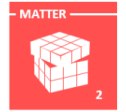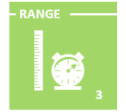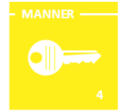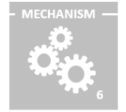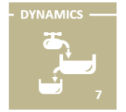Competitiveness - ¨CAP¨ 
(The transaction-wise Manner)

The Competitiveness: how the organization stands in its business, in order to face competition regarding transactions.
Competitiveness is the first element that defines the "Manner" block of the BM. It is linked to the transaction perspective of the business.
Defining the Competitiveness element of a BM is defining the "Competitive Advantage Profile" (CAP) towards competitors, for each kind of transaction, i.e. the way to play the business game through specific competitive advantages.
The CAP basically determines the organization's posture with regard to competition. Competitors are actors who play in the same Domains where transactions take place:
- Market Domain (transactions with targets): actors who fulfill the same needs
- Capture Domain (transactions with customers): actors who try to capture the same budgets
- Capture Domain (transactions with sources): actors who look for benefits associated with the same supplies.
A competitive advantage can result in a preference for the organization from the transaction counterparts (Target Surplus zone or Source Surplus zone), and/or in an opportunity to capture more value as a result of the transaction (Organization Surplus zone).
Looking for Competitiveness1, depending on the nature of the transactions to consider, is done through:
- Offer Differentiation: a better value proposition (resulting from the Market Super-Process), and/or
- Capture differentiation: a better capture (resulting from the Capture Super-Process), and/or
- Lock-in of the transaction counterparts regarding their behavior (resulting from the Industry Super-Process)
Defining the Competitive Advantage Profile is a trade-off, regarding which transactions to prioritize and regarding which competitive options to choose.

CAP can therefore be split between the 3 Super-Processes:
- Market CAP: Competitiveness through Offer Differentiation
- Capture CAP: Competitiveness through Capture Differentiation
- Industry CAP: Competitiveness through Lock-in
(click on the following elements for more details)
> Market CAP
(Playing with Offer Differentiation)
A strong Market CAP aims at gaining a competitive advantage through the differentiation of the value proposition for the targets (for instance, better product quality).
- Offer Differentiation - Better Offer:
The organization may be preferred by its targets over its competitors because of the better offer it delivers. In practice, this situation can express itself in two different ways (or in an intermediate way between the two):
- more delivered value for a similar price (or, more generally speaking, for a similar received value in exchange),
- more delivered value for a higher price (along a market-specific 'upscaling curve').
Better offer can mean better quality, better features, more features, earlier availability etc.
> Capture CAP
(Playing with Capture Differentiation)
A strong Capture CAP aims at gaining a competitive advantage through the differentiation of the capture process, in different possible ways.
CAPTURE ON TARGETS' SIDE:
- Capture Differentiation - Lower Prices:
The organization may be preferred by its targets over its competitors thanks to its lower prices. In practice, this situation can express itself in two different ways (or in an intermediate way between the two):
- similar delivered value for a lower price,
- less delivered value for a lower price (along a market-specific 'downscaling curve').
- Capture Differentiation - Better Capture Efficacy:
The organization may be able to capture the customers' budget better than competitors thanks to a better capture efficacy. In practice, this situation can express itself in three different ways (or in an intermediate way between the three):
- higher prices for a similar delivered value,
- similar prices for less delivered value,
- more transactions for similar prices and delivered value.
CAPTURE ON SOURCES' SIDE:
- Capture Differentiation - Higher Payment:
The organization may be preferred by its sources over its competitors thanks to a higher payment (and/or delivered value) it offers. In practice, this situation can express itself in two different ways (or in an intermediate way between the two):
- similar received value for a higher payment,
- higher received value for a higher payment (along a market-specific 'upscaling curve').
- Capture Differentiation - Lower Requirements:
The organization may be preferred by its sources over its competitors thanks to its lower level of requirements. In practice, this situation can express itself in two different ways (or in an intermediate way between the two):
- less received value for a similar payment,
- less received value for a lower payment (along a market-specific 'downscaling curve').
- Capture Differentiation - Better Capture Efficacy:
The organization may be able to capture the sources' supplies better than competitors thanks to a better capture efficacy. In practice, this situation can express itself in three different ways (or in an intermediate way between the three):
- more received value for similar payment,
- similar received value for less payment,
- more transactions for similar received value and payment.
In all cases, more received value can mean higher quality, more features, better features, more volume per transaction etc.
> Industry CAP
(Playing with Lock-in)
A strong Industry CAP aims at gaining a competitive advantage through a position or mechanism that somehow "locks-in" other actors with regard to transactions.
- Lock-in - Lock-in Mechanisms:
The organization can benefit from lock-in mechanisms in the sames ways as it can benefit from Better Capture Efficacy.
On the Targeting side:
- higher prices for a similar delivered value,
- similar prices for less delivered value,
- more transactions for similar prices and delivered value.
Or on the Sourcing side:
- more received value for similar payment,
- similar received value for less payment,
- more transactions for similar received value and payment.
Lock-ins can be the result of a multitude of factors. For instance:
- Lock-in through standards: Windows could keep its dominating position partially because of the Windows-based standard it imposed on the market.
- Lock-in through market structure: the very fact the industry may be concentrated provides some lock-in position to the competitors, because choices of suppliers are restricted.
- Lock-in through market share: Facebook is by far the biggest online social network, which locks-in its users who won't be able to connect to that many people with alternative web sites.
- Lock-in through access to targets: a restaurant that stands in the middle of a business center somehow locks-in its customer base, although they may be free to choose the competitors.
- Lock-in through existing customer base: owners of HP printers are somehow locked-in with regard to consumption of ink cartriges.
- Lock-in through brand: Coca-Cola locks-in its professional customers thanks to its brand, as the demand of consumers imposes them to provide Coca-Cola drinks.
- Lock-in through contractual terms: mobile phone operators lock-in their customers when they impose a 1 or 2 year contract.
- ...
1- Competitive advantage is often used in two different ways: as a strategic advantage over competitors with regard to the ability to perform transactions in favorable conditions (usually involving "price premium" or "customer preference"), or as a strategic advantage over competitors with regard to operational effectiveness or efficiency (involving for instance lower costs, better productivity or higher asset turnovers). In the Bm2 framework, we use the first definition, the second being related to "Effectiveness" and "Efficiency", potentially source of competitive advantage.
Scales < PREVIOUS - NEXT > Effectiveness

